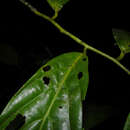Description
provided by Phytokeys
Trees or shrubs (0.5–)1.5–20 m tall; young twigs and petioles glabrous to densely covered with appressed or erect, simple, whitish to golden, up to 1 mm long hairs. Leaves distichous, simple, entire, petiolate, exstipulate; lamina elliptic to obovate or narrowly so, index 1.6–5, chartaceous to coriaceous, glabrous (rarely sparsely covered with appressed or erect, simple, up to 1 mm long hairs) above, glabrous to densely hairy (particularly at the base and on veins) below, base acute, obtuse or rounded, rarely subcordate to cordate, apex acuminate, sometimes caudate, rarely obtuse to acute, extreme tip rounded, venation brochidodromous, primary vein raised over entire leaf length above with an often conspicuous longitudinal groove particularly in the basal half, secondary veins 5–20(–30) on either side of the primary vein, often with 1–6 intersecondary veins, running parallel to primary vein for a short distance, thereafter angles with primary vein either increasing or decreasing towards the apex (or consistent), sometimes branching, often forming distinct loops, smallest distance between loops and margin 1–7 mm, tertiary veins percurrent (or reticulate). Inflorescence of single flowers or occasionally up to 8 in a rhipidium, pendant, clustered in groups of up to 7, terminal on short axillary shoots (i.e. peduncles) on leafy or leafless twigs, older branches or on the main trunk (then often on brachyblasts); 1-several lower bracts, deltate to depressed ovate, rarely narrowly elliptic, leafy, rounded to acute, soon falling off or persistent; single upper bract attached to pedicel, ovate to deltate, acute to obtuse; flower buds open or closed in development, when closed (ovoid to triangular) broadly to depressed ovoid; peduncles, pedicels, outer sides of bracts, sepals and petals glabrous to densely covered with appressed or erect, simple, up to 1 mm long hairs, bracts, sepals and petals ciliate. Flowers actinomorphic, bisexual, with one whorl of free or slightly connate, imbricate, sepals and two whorls of free, imbricate, petals, green, creamy or yellow in vivo, often black in sicco; sepals and petals thin at margins, occasionally with prominent venation; sepals three, much smaller than petals; petals six, the outer ones ovate, elliptic or broadly so, the inner ones elliptic to obovate or narrowly so, stamens numerous (ca. 100), spirally arranged, extrorse, inserted on and below a ventral ridge encircling a central depression in the receptacle in which the carpels are inserted, 1–2 mm long, connective appendage transversely rhombic-hexagonal; carpels 20–40, spirally arranged, free, ovary 1-locular, glabrous or hairy, with 1 basal, lateral or apical ovule (reported by Van Heusden 1992), stigma sessile. Fruit apocarpous, monocarps 5–40, stipitate, mostly asymmetrical, sometimes strongly so, sometimes with an (often excentric) apicule, green maturing mostly through red to brown or black in vivo, light brown to black in sicco. Seeds 1, lateral or apical (reported by Van Setten & Koek-Noorman 1992), ellipsoid to globose, yellow to reddish-brown, surface deeply to shallowly pitted, lacking an aril, with a raised or sunken raphe encircling seed longitudinally (diagonally), regularly (or more sinuously), ruminations spiniform.
- license
- cc-by-3.0
- copyright
- Michael D. Pirie, Lars W. Chatrou, Paul J. M. Maas
- bibliographic citation
- Pirie M, Chatrou L, Maas P (2018) A taxonomic revision of the Neotropical genus Cremastosperma (Annonaceae), including five new species PhytoKeys (112): 1–141
- author
- Michael D. Pirie
- author
- Lars W. Chatrou
- author
- Paul J. M. Maas
Distribution
provided by Phytokeys
34 species in the Neotropics: from southern Costa Rica in the north to Bolivia in the south. Most species are distributed in regions surrounding the Andean mountain range, two in coastal Venezuela (Cremastospermamacrocarpum Maas and C.venezuelanum Pirie), one in French Guiana (C.brevipes (DC.) R.E.Fr.) and one widespread across Brazil, south of the Amazon River (C.monospermum (Rusby) R.E.Fr.).
- license
- cc-by-3.0
- copyright
- Michael D. Pirie, Lars W. Chatrou, Paul J. M. Maas
- bibliographic citation
- Pirie M, Chatrou L, Maas P (2018) A taxonomic revision of the Neotropical genus Cremastosperma (Annonaceae), including five new species PhytoKeys (112): 1–141
- author
- Michael D. Pirie
- author
- Lars W. Chatrou
- author
- Paul J. M. Maas
Cremastosperma: Brief Summary
provided by wikipedia EN
Cremastosperma is a genus of flowering plants in the family Annonaceae, subfamily Malmeoideae, tribe Malmeae. In 2018 there were 34 recognised species distributed in Central and South America.
Cremastosperma was described by Robert Elias Fries in 1930, based on Aberemoa pedunculata Diels, originally described by Ludwig Diels (1906), which thus became the type species Cremastosperma pedunculatum (Diels) R.E.Fr..
Species of Cremastosperma are found in lowland to pre-montane tropical forest in the Neotropics. The greatest species diversity is distributed in the narrow tropical zone to the west of the Andean mountain chain on the Pacific Ocean side of north-western South America, north into Central America as far as Costa Rica; and on the eastern side of the Andes extending from Colombia through eastern Ecuador and Peru as far south as Bolivia. Two species are found in coastal Venezuela (Cremastosperma macrocarpum Maas and Cremastosperma venezuelanum Pirie), and one in French Guiana (Cremastosperma brevipes (DC.) R.E.Fr.).
- license
- cc-by-sa-3.0
- copyright
- Wikipedia authors and editors

